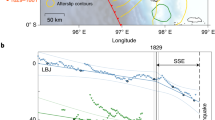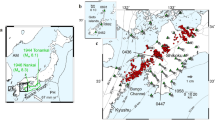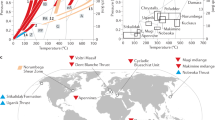Abstract
Slow slip events have become recognized in the last decade as an important mode of fault slip, and are most widely observed at subduction zones. Many episodes of tectonic tremor (related to slow slip) have been triggered by distant earthquakes due to dynamic-stress changes from passing seismic waves. However, there are few clear examples of large, geodetically detected slow slip events triggered by distant earthquakes. Here we use analyses of seismic and geodetic data to show that the magnitude 7.8 Kaikōura earthquake in New Zealand in 2016 triggered a large slow slip event between 250 and 600 km away. The slow slip was shallow, at less than 15 km deep, and spanned more than 15,000 km2 of the central and northern Hikurangi subduction margin. The slow slip initiated immediately after the earthquake, lasted one to two weeks and was accompanied by a swarm of seismicity. We show that changes in dynamic stress in the slow slip source area ranged from 100 to 600 kPa—approximately 1,000 times greater than the static-stress changes of 0.2 to 0.7 kPa. We therefore propose that the slow slip event was triggered by dynamic-stress changes caused by passing seismic waves. Furthermore, the dynamic-stress changes were greatest on the shallow subduction interface, at less than 10 km depth, in a region overlain by a sedimentary wedge that acts as a waveguide, trapping seismic energy and probably promoting triggering of slip. This suggests that shallow slow slip events are more easily triggered by dynamic-stress changes compared with deep events.
This is a preview of subscription content, access via your institution
Access options
Access Nature and 54 other Nature Portfolio journals
Get Nature+, our best-value online-access subscription
$29.99 / 30 days
cancel any time
Subscribe to this journal
Receive 12 print issues and online access
$259.00 per year
only $21.58 per issue
Buy this article
- Purchase on Springer Link
- Instant access to full article PDF
Prices may be subject to local taxes which are calculated during checkout




Similar content being viewed by others
References
Dragert, H., Wang, K. & James, T. A silent slip event on the deeper Cascadia subduction interface. Science 292, 1525–1528 (2001).
Beroza, G. C. & Ide, S. Slow earthquakes and nonvolcanic tremor. Annu. Rev. Earth Planet. Sci. 39, 271–296 (2011).
Peng, Z. & Gomberg, J. An integrated perspective of the continuum between earthquakes and slow-slip phenomena. Nat. Geosci. 3, 599–607 (2010).
Schwartz, S. Y. & Rokosky, J. M. Slow slip events and seismic tremor at circum-pacific subduction zones. Rev. Geophys. 45, RG3004 (2007).
Kato, A. et al. Propagation of slow slip leading up to the 2011 Mw 9.0 Tohoku-Oki earthquake. Science 335, 705–708 (2012).
Ito, Y. et al. Episodic slow slip events in the Japan subduction zone before the 2011 Tohoku-Oki earthquake. Tectonophysics 600, 14–26 (2013).
Obara, K. & Kato, A. Connecting slow earthquakes to huge earthquakes. Science 353, 253–257 (2016).
Radiguet, M. et al. Triggering of the 2014 Mw 7.3 Papanoa earthquake by a slow slip event in Guerrero, Mexico. Nat. Geosci. 9, 829–834 (2016).
Ruiz, S. et al. Intense foreshocks and a slow slip event preceded the 2014 Iquique Mw 8.1 earthquake. Science 345, 1165–1169 (2014).
Peng, Z. & Chao, K. Non-volcanic tremor beneath the Central Range in Taiwan triggered by the 2001 Mw7.8 Kunlun earthquake. Geophys. J. Int. 175, 825–829 (2008).
Rubinstein, J. L. et al. Seismic wave triggering of nonvolcanic tremor, episodic tremor and slip, and earthquakes on Vancouver Island. J. Geophys. Res. 114, B00A01 (2009).
Fry, B., Chao, K., Bannister, S., Peng, Z. & Wallace, L. Deep tremor in New Zealand triggered by the 2010 Mw8.8 Chile earthquake. Geophys. Res. Lett. 38, L15306 (2011).
Francoiş-Holden, C. et al. The MW 6.6 Gisborne Earthquake of 2007: preliminary records and general source characterisation. Bull. NZ Soc. Earthq. Eng. 41, 266–277 (2008).
Hirose, H., Hirahara, K., Kimata, F., Fujii, N. & Miyazaki, S. A slow thrust slip event following the two 1996 Hyuganada Earthquakes beneath the Bungo Channel, southwest Japan. Geophys. Res. Lett. 26, 3237–3240 (1999).
Itaba, S. & Ando, R. A slow slip event triggered by teleseismic surface waves. Geophys. Res. Lett. 38, L21306 (2011).
Zigone, D. et al. Triggering of tremors and slow slip event in Guerrero, Mexico, by the 2010 Mw8.8 Maule, Chile, earthquake. J. Geophys. Res. 117, http://dx.doi.org/10.1029/2012JB009160 (2012).
Araki, E. et al. Recurring and triggered slow slip events near the trench at the Nankai Trough subduction megathrust. Science 356, 1157–1160 (2017).
Hirose, H., Kimura, H., Enescu, B. & Aoi, S. Recurrent slow slip event likely hastened by the 2011 Tohoku earthquake. Proc. Natl Acad. Sci. USA 109, 15157–15161 (2012).
Wei, M., Liu, Y., Kaneko, Y., McGuire, J. & Bilham, R. Dynamic triggering of creep events in the Salton Trough, Southern California by regional M ≥ 5.4 earthquakes constrained by geodetic observations and numerical simulations. Earth Planet. Sci. Lett. 427, 1–10 (2015).
Peng, Z., Shelly, D. R. & Ellsworth, W. L. Delayed dynamic triggering of deep tremor along the Parkfield-Cholame section of the San Andreas Fault following the 2014 M6.0 South Napa earthquake. Geophys. Res. Lett. 42, 7916–7922 (2015).
Hamling, I. J. et al. Complex multi-fault rupture during the 2016 Mw 7.8 Kaikōura earthquake, New Zealand. Science 356, 6334 (2017).
Kaiser, A. et al. The Kaikōura (New Zealand) earthquake: preliminary seismological report. Seismol. Res. Lett. 88, 727–739 (2017).
Wallace, L. M. & Beavan, J. Diverse slow slip behavior at the Hikurangi subduction margin, New Zealand. J. Geophys. Res. 115, B12402 (2010).
McCaffrey, R. Time-dependent inversion of three-component continuous GPS for steady and transient sources in northern Cascadia. Geophys. Res. Lett. 36, GL036784 (2009).
Williams, C. A. et al. Revised interface geometry for the Hikurangi subduction zone, New Zealand. Seismol. Res. Lett. 84, 1066–1073 (2013).
Segall, P. & Matthews, M. Time dependent inversion of geodetic data. J. Geophys. Res. 102, 22391–22409 (1997).
Miyazaki, S., Segall, P., McGuire, J. J., Kato, T. & Hatanaka, Y. Spatial and temporal evolution of stress and slip rate during the 2000 Tokai slow earthquake. J. Geophys. Res. 111, B03409 (2006).
Wallace, L. M., Beavan, J., Bannister, S. & Williams, C. Simultaneous long-term and short-term slow slip events at the Hikurangi subduction margin, New Zealand: implications for processes that control slow slip event occurrence, duration, and migration. J. Geophys. Res. 117, B11402 (2012).
Bartlow, N. M., Wallace, L. M., Beavan, R. J., Bannister, S. & Segall, P. Time-dependent modeling of slow slip events and associated seismicity and tremor at the Hikurangi subduction zone, New Zealand. J. Geophys. Res. 119, 734–753 (2014).
Ristau, J. Implementation of routine regional moment tensor analysis in New Zealand. Seismol. Res. Lett. 79, 400–415 (2008).
Meng, L., Huang, H., Bürgmann, R., Ampuero, J. P. & Strader, A. Dual megathrust slip behaviors of the 2014 Iquique earthquake sequence. Earth Planet. Sci. Lett. 411, 177–187 (2015).
Kodaira, S. et al. High pore fluid pressure may cause silent slip in the Nankai Trough. Science 304, 1295–1298 (2004).
Liu, Y. & Rice, J. R. Spontaneous and triggered aseismic deformation transients in a subduction fault model. J. Geophys. Res. 112, B09404 (2007).
Rubinstein, J. L., La Rocca, M., Vidale, J. E., Creager, K. C. & Wech, A. G. Tidal modulation of nonvolcanic tremor. Science 319, 186–189 (2008).
Thomas, A., Nadeau, R. M. & Bürgmann, R. Tremor-tide correlations and near-lithostatic pore pressure on the deep San Andreas fault. Nature 462, 1048–1051 (2009).
Hamling, I. J. et al. Stress transfer between thirteen successive dyke intrusions in Ethiopia. Nat. Geosci. 3, 713–717 (2010).
Wallace, L. M. et al. The kinematics of a transition from subduction to strike-slip: an example from the central New Zealand plate boundary. J. Geophys. Res. 117, B02405 (2012).
King, G. C., Stein, R. S. & Lin, J. Static stress changes and the triggering of earthquakes. Bull. Seismol. Soc. Am. 84, 935–953 (1994).
Cochran, E., Vidale, J. & Tanaka, S. Earth tides can trigger shallow thrust fault earthquakes. Science 306, 1164–1166 (2004).
van der Elst, N. J. & Brodsky, E. E. Connecting near-field and far-field earthquake triggering to dynamic strain. J. Geophys. Res. 115, B07311 (2010).
Hill, D. P. & Prejean, S. in Treatise on Geophysics Vol. 4, 2nd edn (ed. Kanamori, H.) 273–304 (Elsevier, 2015).
Olsen, K. B. et al. Strong shaking in Los Angeles expected from southern San Andreas earthquake. Geophys. Res. Lett. 33, L07305 (2006).
Gomberg, J. Permanently enhanced dynamic triggering probabilities as evidenced by two M > 7.5 earthquakes. Geophys. Res. Lett. 40, 4828–4833 (2013).
Fan, W. & Shearer, P. M. Fault interaction and triggering during the 10 January 2012 Mw 7.2 Sumatra earthquake. Geophys. Res. Lett. 43, 1934–1942 (2016).
Saffer, D. M. & Wallace, L. M. The frictional, hydrologic, metamorphic, and thermal habitat of shallow slow earthquakes. Nat. Geosci. 8, 594–600 (2015).
Kamei, R., Pratt, R. G. & Tsuji, T. Waveform tomography imaging of a megasplay fault system in the seismogenic Nankai subduction zone. Earth Planet. Sci. Lett. 317–318, 343–353 (2012).
Bassett, D., Sutherland, R., and, S. & Henrys, S. Slow wavespeeds and fluid overpressure in a region of shallow geodetic locking and slow slip, Hikurangi subduction margin, New Zealand. Earth Planet. Sci. Lett. 389, 1–13 (2014).
Bangs, N. L. B., Westbrook, G. K. & Ladd, J. W. Seismic velocities from the Barbados ridge complex: indicators of high pore fluid pressures in an accretionary complex. J. Geophys. Res. 95, 8767–8782 (1990).
Bartlow, N. M., Miyazaki, S., Bradley, A. M. & Segall, P. Space-time correlation of slip and tremor during the 2009 Cascadia slow slip event. Geophys. Res. Lett. 38, L18309 (2011).
Komatitsch, D. & Tromp, J. Introduction to the spectral elemental method for three-dimensional seismic wave propagation. Geophys. J. Int. 139, 806–822 (1999).
Komatitsch, D. & Vilotte, J.-P. The spectral element method: an efficient tool to simulate the seismic response of 2D and 3D geological structures. Bull. Seismol. Soc. Am. 88, 368–392 (1998).
Eberhart-Phillips, D., Reyners, M., Bannister, S., Chadwick, M. & Ellis, S. Establishing a versatile 3-D seismic velocity model for New Zealand. Seismol. Res. Lett. 81, 992–1000 (2010).
Eberhart-Phillips, D. & Banninster, S. 3-D imaging of the northern Hikurangi subduction zone, New Zealand: variations in subducted sediment, slab fluids, and slow slip. Geophys. J. Int. 201, 838–855 (2015).
Kaiser, A., Van Houtte, C., Perrin, N., Wotherspoon, L. & McVerry, G. Site characterisation of GeoNet stations for the New Zealand strong motion database. Bull. NZ Soc. Earthq. Eng. 50, 39–49 (2017).
Peng, Z. & Ben-Zion, Y. Spatio-temporal variations of crustal anisotropy from similar events in aftershocks of the 1999 M7.4 İzmit and M7.1 Düzce, Turkey, earthquake sequences. Geophys. J. Int. 160, 1027–1043 (2005).
Press, W. H. FORTRAN Numerical Recipes: Numerical Recipes in FORTRAN 90 (Cambridge Univ. Press, 1996).
Acknowledgements
We thank www.geonet.org.nz for providing the cGPS and seismological data, and AllTerra NZ for additional GPS data. We acknowledge funding support for this work from GNS Science, the Marsden Fund of the Royal Society of New Zealand, and the NZ Ministry for Business, Innovation, and Employment (MBIE). L.M.W. and N.B. acknowledge support from NSF grants OCE-1551876 and OCE-1551929. We wish to acknowledge the contribution of the NeSI high-performance computing facilities to the results of this research. New Zealand’s national facilities are provided by the NZ eScience Infrastructure and funded jointly by NeSI’s collaborator institutions and through MBIE’s Research Infrastructure programme.
Author information
Authors and Affiliations
Contributions
L.M.W. conceived the study, undertook the TDEFNODE inversions, and led the writing of the paper. Y.K. undertook the dynamic-stress-change modelling, and contributed to the interpretations and writing of the paper. N.B. was responsible for the Network Inversion Filter inversions. I.H. undertook the Coulomb stress change modelling. S.H. and E.D’A. undertook processing of the cGPS data. Z.P. and B.F. contributed locations of repeaters during the SSE and provided seismological expertise and insights into remote triggering of SSEs.
Corresponding author
Ethics declarations
Competing interests
The authors declare no competing financial interests.
Supplementary information
Supplementary Information
Supplementary Information (PDF 2736 kb)
Supplementary Information
Supplementary Information (MP4 5283 kb)
Supplementary Information
Supplementary Information (MP4 6879 kb)
Rights and permissions
About this article
Cite this article
Wallace, L., Kaneko, Y., Hreinsdóttir, S. et al. Large-scale dynamic triggering of shallow slow slip enhanced by overlying sedimentary wedge. Nature Geosci 10, 765–770 (2017). https://doi.org/10.1038/ngeo3021
Received:
Accepted:
Published:
Issue Date:
DOI: https://doi.org/10.1038/ngeo3021
This article is cited by
-
Slow slip events following the afterslip of the 2002 Mw 7.1 Hualien offshore earthquake, Taiwan
Earth, Planets and Space (2022)
-
Slow deformation event between large intraslab earthquakes at the Tonga Trench
Scientific Reports (2021)
-
Physical conditions and frictional properties in the source region of a slow-slip event
Nature Geoscience (2021)
-
Calibrating the marine turbidite palaeoseismometer using the 2016 Kaikōura earthquake
Nature Geoscience (2021)
-
Short-term interaction between silent and devastating earthquakes in Mexico
Nature Communications (2021)



